Patricia Piccinini believes that emotional connections go beyond the known frontiers. She shows us through her hyper-realistic art that humanity is indeed capable to love more than they know.
By Koay Choon Sean
Frigyes Karinthy, a Hungarian author, first coined the theory of “six degrees of separation” in his 1929 short story, Chains. It alludes to the idea that everyone is only six social connections away from one another. But as the world shrinks (literally), two perfect strangers are only a “Follow” button away from each other.
Beyond the social connection between humans, what if we attempt to understand our broader relationship with all forms of life—even those of hybrid or mutation? How connected are you to both the familiar and the unknown?
It’s a daunting prospect, but Patricia Piccinini is not fazed to explore the depths of our psyches at the intersection of art and science.
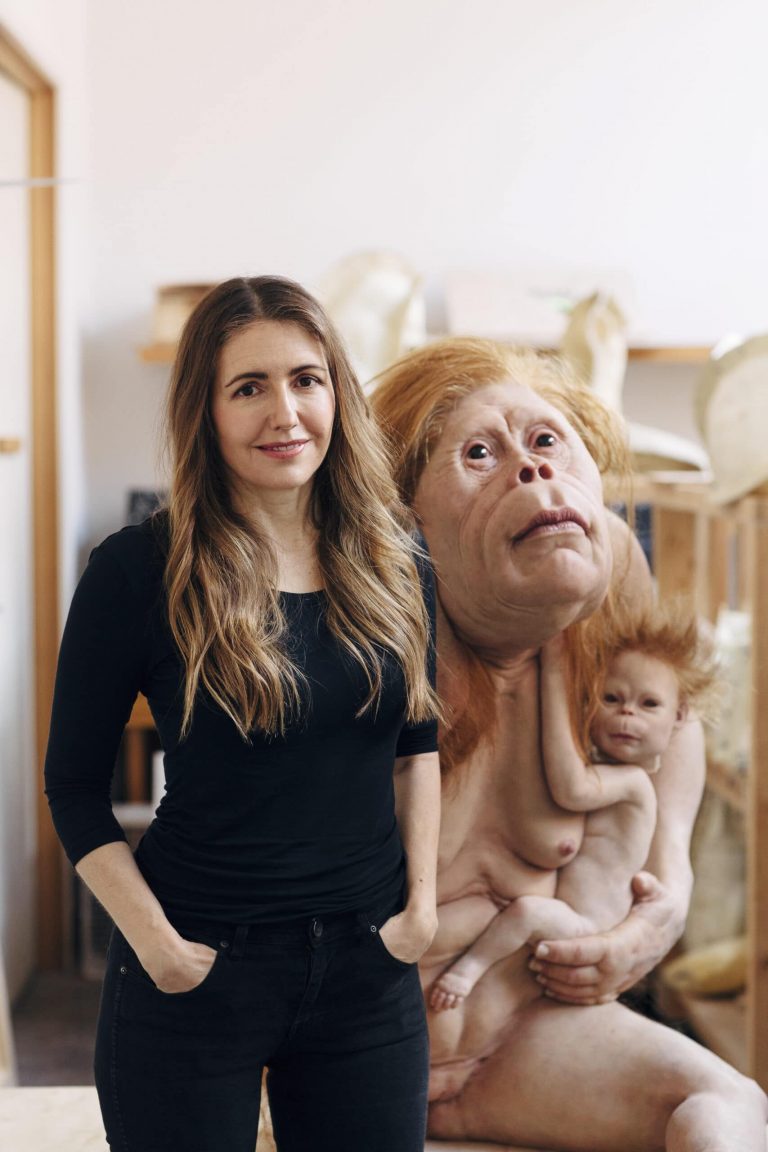
Patricia Piccinini (left) with Kindred (2018). Photo courtesy of the artist and the Institute for Cultural Exchange. (Photographed by Hilary Walker)
AT THE CROSSROAD
Piccinini’s works evoke curiosity for the unknown, but the Sierra Leone-born, Melbourne-based artist is no stranger to the art fraternity. As one of Australia’s most acclaimed contemporary artists, her hyper-realism works have been exhibited extensively across the world including a major representation of Australia at the 2003 Venice Biennale.

The Young Family (2002), the centerpiece of the “We Are Family” exhibition by Piccinini, was Australia’s official representation for the 50th Venice Biennale, 2003.
For the past thirty years, Piccinini has traversed on the edge of art and science, with a reflection towards the past as well as the future, to bring forth narratives that underscore our negligence of the biosphere around us. Her repertoire of lifelike sculptures and spellbinding installations are the artefacts of complex processes using a variety of mediums such as silicone, fiberglass, resin, and other eccentric components.
But the true enchantment of her works lies in her gift of conjuring profound connections between the artworks and the audiences. Strange as her oeuvre might be, each piece exudes no sense of malice but one of warmth, intimacy, and indefinable bond.
It is almost as though we are seeing ourselves in Piccinini’s shoes. Along with that, she prompts us to question our human values against our need for survival through scientific advancements and technological developments. For a future built at the expense of others, what will become of our next generation?
Or rather, how much of humanity will be left intact by then?
WE ARE CONNECTED
The theme of connection carries through in Piccinini’s first major exhibition in Southeast Asia, We Are Connected, that features more than forty artworks that span seven sections of the ArtScience Museum in Singapore.
Penang Art District had the opportunity to speak to her on the meaning of connection, the narrative behind her artworks, and her perspective of the future.
Thanks for having me, Patricia. I had the opportunity to tour your exhibition at ArtScience Museum the other day, and I was dumbfounded at what I saw—in a good way.
I am glad to hear that. Are there any particular works that piqued your interest?
As a matter of fact, there are two. But The Welcome Guest is my primary pick if I have to choose between them.
That is very surprising. Would you mind sharing with me the reason, or your thoughts behind it?
The whole composition of it; the contrast between the subjects in the piece are very intriguing. The sloth-like creature with its strange, hybrid constituents did not seem to suggest a wicked aura. Rather, there is a sense of welcoming—like a friend from the wilds. The little girl facing the creature has an expression that justifies my point. Her playful expression towards the bizarre being is a juxtaposition against the expected, and it seems like she is ready to pull the creature into her embrace. Then you have a peacock in all its glory behind the creature that plays into the contrast of the familiar and the unknown.
It is not wrong to say that a possible exchange of love did happen between the little girl and the creature. There is a recognisable connection there that is close to a family bond. The sloth-like being is bound to induce anxiety in the spectators from a distance because it is foreign. We have suspicion of the unknown hardwired into us, but that gives us the facility to question and find answers.
The conspicuous peacock is, however, an allusion to Johann Wolfgang von Goethe’s quote that reads: “Beauty is everywhere a welcome guest”. It is familiar and its nature-given beauty is perceptible. Then you have the uncanny creature that plays into the context of mystery. Yet—and against the predictable—the little girl chooses to embrace the creature. Is it because there is a deeper connection between the two of them? Is beauty then, a welcome guest?
More than anything, I believe that humanity values connection and our survival hinges upon it. It is our bond with one another that drives us to live. But with the development of science—such as genetic engineering—will it change what was once familiar to an alien state? Will we then continue to welcome the very beings that we created? How will we interpret our connection with them? These are the questions that I intend to push through this work.
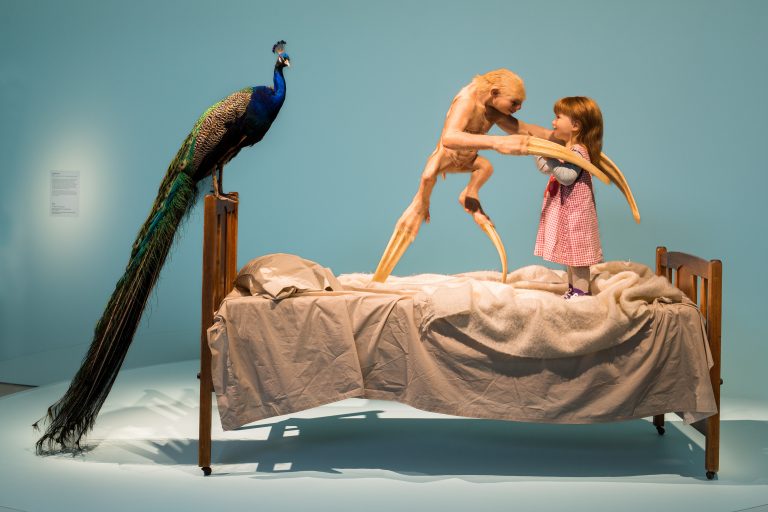
Patricia Piccinini, The Welcome Guest, 2011. (Photo credit: Marina Bay Sands)
I see the layers of thought there. In Sanctuary—my second favourite work in the exhibition—I did sense a similar narrative. Would you agree?
The context of love is quite prevalent when we explore the theme of connection. In modern society, the expression of love has been primarily contextualised through youths.
But in Sanctuary, I want to reflect on the emotional relationship across generations and species. Love is not just reserved for homo sapiens—that is the least that we can all agree upon.
I used African Bonobos as the subject for this work because genetically, they are the closest to us. Again, it plays into the idea that we are all connected, and that connection extends beyond our lineages and genetic factors.
However, I would want the spectators to reflect on their interpretation of the subject. Are they from the past, or are they of the future? Again, with science, there are many open-ended possibilities that we have yet to experience. I use the arts as a platform to seek those answers.
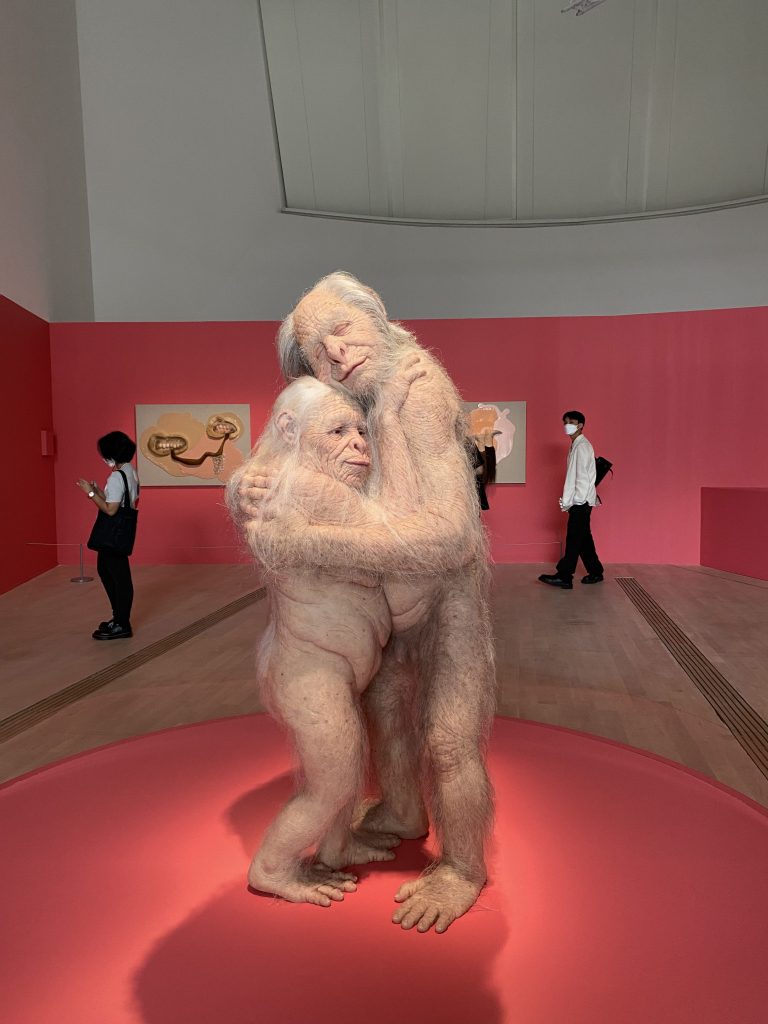
Sanctuary, 2018.
Before we go further, I am interested to know your take on the context of connection. It is, after all, the central theme for most of your pieces.
[Connection] is a very broad subject. Personally, it has never been about differences from one another. It is how we understand the interplay between both the natural and the artificial (in this case, genetic engineering), and how those forces change themselves in different contexts.
As you can see, I tend to amalgamate both in my works. Through that dynamic, we can highlight alarming issues that stem from both spheres. Then, as human spectators that stand in between the natural and the artificial, we can review our connections to them by putting ourselves in their shoes. Empathy is a powerful sentiment.
I always strive to produce works that engage emotionally with the audience. It is against me to make pieces that shame people because it will work against the whole idea of connection. We Are Connected is more than just a thread between my works—it is also [a thread] between the spectators and within themselves.
On that note, let us talk about the key to unlocking that connection. Despite having ominous appearances, your various works do not trigger a sense of threat to or withdrawal from the audience. After touring We Are Connected, I might have found the answer to that. It is the eyes, is it not?
You are absolutely correct! Every human is wired with the propensity to connect with people through their eyes—hence the idiom of “the eyes are the window to the soul”. Our eyes enable us to establish a gateway to understanding others, and that is why we put so much emphasis on the crafting of the eyes in the sculptures.
Each eye is individually made and painted in the studio to resemble the eyes that we are all familiar with—even though the other constituents might be foreign to us.
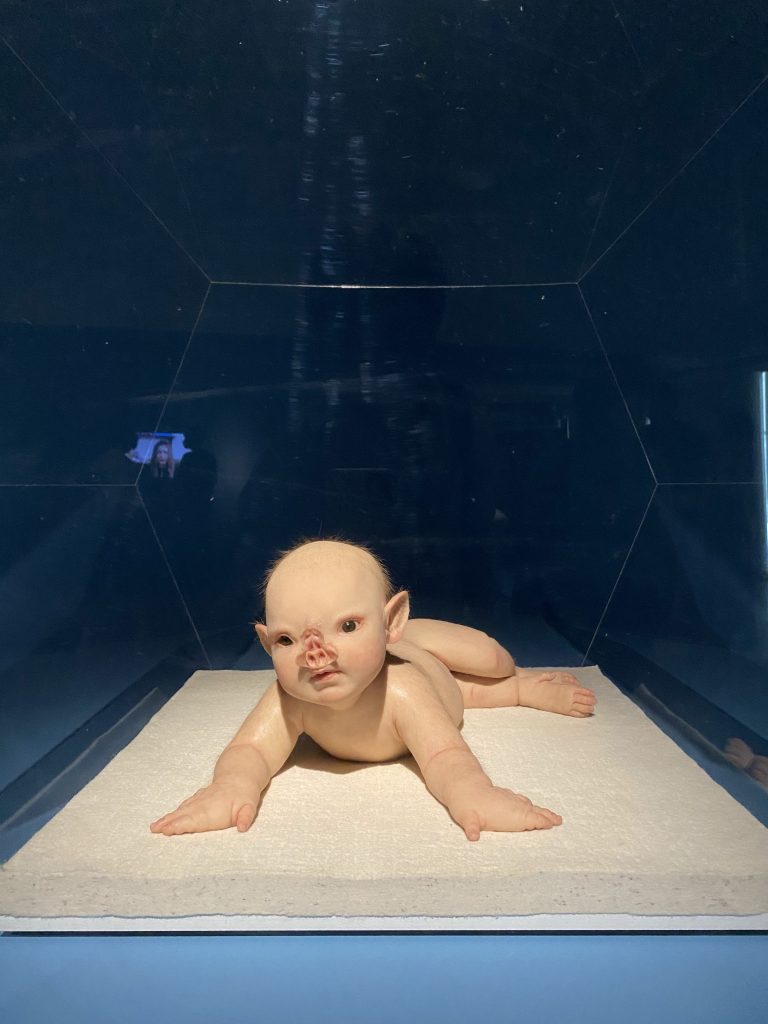
Prone (detail), 2011.
I also detected the use of hair in most of your works. The variety of mediums that you employ is truly fascinating. Could you share with us their importance to your works and how that informs your practice as an artist?
To be honest, the medium is not exactly the most crucial element in my practice. It is just a vehicle for the idea that I am executing, but it certainly requires great technical precision, nonetheless. For silicone alone, I have eight people in the team to develop its working process!
Having said that, I am always on the lookout for new mediums to explore. Through my various residencies with other artists and studios, I find new narratives through the exploration of techniques with both new and known materials. It is part of the process to develop technical excellence as an artist.
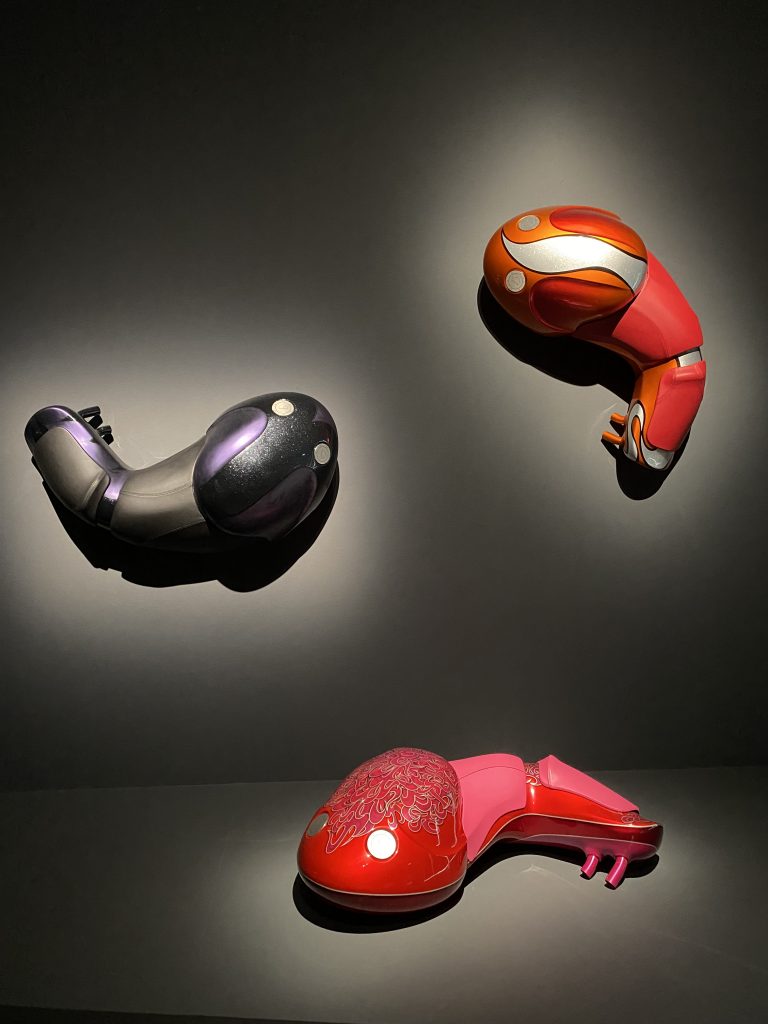
Black Velvet, Hunter, Highlander, 2005.
Is there a medium that you are looking forward to trying?
Glass! You have to blow using your breath to shape glasses, and the mouth is also a primary communication medium. The outcome is very arbitrary and the prospect excites me.
What can we expect next?
I am always captivated by the evolutionary journey of animals and their sustainability in the world. After the recent flood in Australia, a lake miraculously reappeared and a squadron of pelicans suddenly returned to it! How did they know? That’s very beguiling.
I am also studying a natural constituent called mycelium, which is the structure inside a fungus. It is an essential body that connects to the forest ecosystem and is capable of both healing as well as construction.
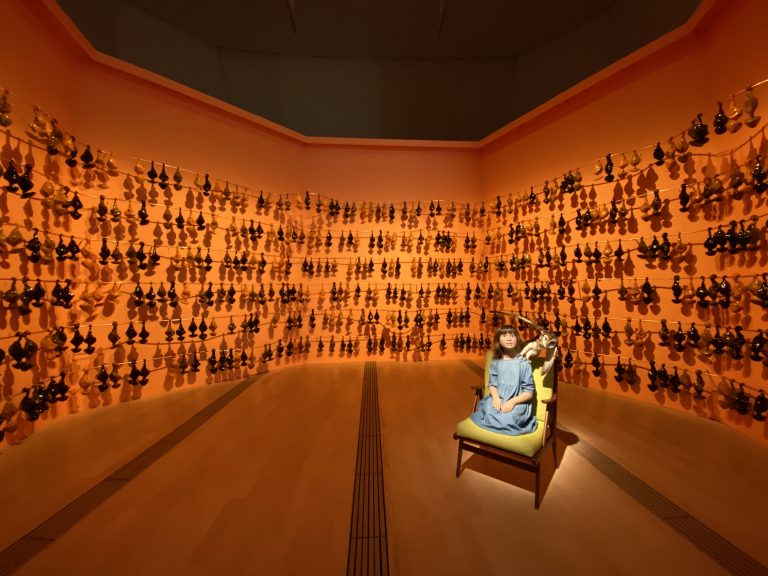
The Grotto, 2018.
Honestly, we are excited about anything that comes from you. Before we end this interview, I would love to know your perspective on the future of humanity as an artist that navigates the frontier of art and science.
I am apprehensive about the future, particularly for the coming generations. We are on the verge of a catastrophic nuclear threat that will cause unimaginable damage to the planet and its inhabitants. There will be no getting back from there if it happens, and it is very upsetting to think that we are the cause of it.
Patricia Piccinini: We Are Connected is currently running at ArtScience Museum, Singapore until 29 January 2023.
Koay Choon Sean (Andy) reads just about anything and everything. Is he a writer too? Maybe. His life is all about curiosity.
The author would like to thank Patricia Piccinini, Kim of Milk PR, ArtScience Museum, and Marina Bay Sands (Geena Hui and Julia Tan) for their tremendous support towards the materialisation of this feature piece.
Cover photo: Patricia Piccinini, The Bond, 2016.
All photos by Koay Choon Sean, except as indicated otherwise.

